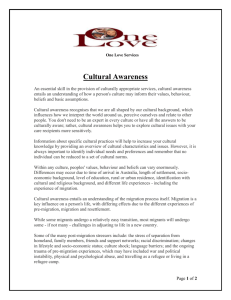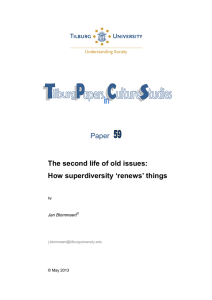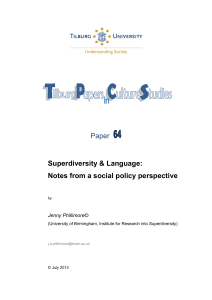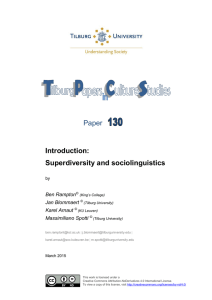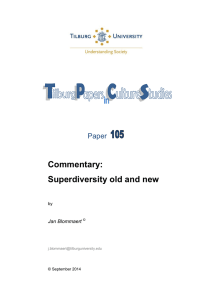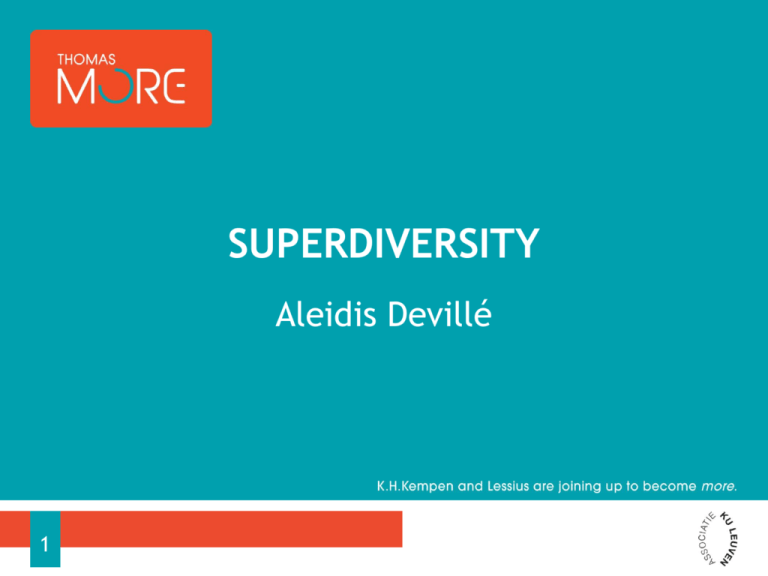
SUPERDIVERSITY
Aleidis Devillé
1
INTRODUCTION
OBSERVATIONS
• Evolution in most European countries in less
than a century:
− Composition of societies evolved from ‘limited
ethno-cultural diversity’ towards ‘immigration
societies’
− Result of succeeding migration waves: much
more complex social realities, especially in the
cities
• Qualitative and quantitative differences as
compared to migration in the 20th century
2
SUPERDIVERSITY
• More than a synonym
for ‘diversity’ or
‘multi culturality’
• New phase in
migration and
demography
• Term by Steven
Vertovec
3
‘MAJORITY-MINORITY’ CITIES
• Diversity increases, especially in big cities
• Term: ‘majority-minority city’:
− A city where the majority of the inhabitants is
composed of minority groups
Examples
− World capitals like New York, Sao Paolo,
Toronto or Sydney
− In Belgium: Brussels (today); Genk, Antwerps,
Ghent, … (tomorrow)
− Today and tomorrow: everywhere in the world
4
EXAMPLE
ANTWERP: KIDS OF ALL COLORS (1)
5
EXAMPLE
ANTWERP: KIDS OF ALL COLORS (2)
6
EXEMPLE
BRUSSELS: A MIXTURE OF LANGUAGES
• More then 100 different languages
− A.o.: French (89%), English (30%), Dutch (23%),
Arab (18%)
• Individuals combining multiple languages
− Less than 40% are mono-lingual French or
Dutch speaking
− One out of tree citizens grow up in a family
lacking the knowledge of Dutch or French
7
THE NATURE OF MIGRATION
1990
- More people migrate, from more
countries, to more countries
- very diverse background of
immigrants
- a limited number of
countries of origin
- people opting for particular
host countries
8
TYPOLOGY OF NOWADAYS MIGRANTS
Migrants differ in:
• beliefs and
opinions
• experiences
• prosperity
• lifestyle
• level of education
• …
•9 Diversiteit in &
• Diversity in socio-
economical
positions
• Diversity in &
between
communities
• More transnationalism
EXAMPLE
FAMOUS BELGIANS OF MIXED BACKGROUND
People from
your
country
• The longer the more Belgians combine a
Belgian identity with a mixed background
National
Stromae
10
Vincent
Kompany
DIVERSITY AND NEW COMMUNICATION
TECHNOLOGIES
New technologies enable:
• Keeping in touch (mobiles, internet, skype,
satellite television, …)
• Building very different social relations
• Virtuals networks
11
DEALING WITH SUPERDIVERSITY
• Superdiversity is a factual
constatation
− Not to be judged as ‘good’ or ‘bad’
− The impact depends on how we deal with it
• The situation may be considered
− as a milestone raising new questions
− as a new light shining over the context of
migration and integration
12
PARADIGM SHIFT
From: ethnic-cultural approach
To: dealing with superdiversity
ETHNIC-CULTURAL
APPROACH
The national, ethnic or religious
background of a person is the
most important characteristic
of a person’s identity
and the main explanation
for her or his behaviour
DAVID PINTO
• Collectivistic
• Group-cultures
• We - cultures
individual
• Individualistic
• Person-oriented
cultures
• I - cultures
individual
KNOWLEDGE OF CULTURAL AND
MIGRATION- BACKGROUNDS IMPORTANT!
• Sometimes necessary (e.g. ethnopharmacy)
• Helps to understand the communication
RISKS OF A ETHNICCULTURAL APPROACH
• Reduces a person to only her/his national, ethnic or
•
•
•
•
•
•
•
religious identity
Culture used as a variable, instrumental explanation
Culturalises all kind of differences and makes behavior
extra-ordinary
Culture: homogenous and static
Generalises and stereotypes
Only one meaning
Not-equal and patronizing
Takes you out of your power, your balance and it takes the
other person also out of her/his power/balance
EACH PERSON IS PART OF
MANY COLLECTIVES
……….
Gender
Age
Religion
Profession
Ethnic
group
Social-economic
position
Nationality
Parentship
Coutryside/
/ city
Sexual
orientation
IDENTITY: A MULTIPLE, COLOURFUL
AND MOVING MOSAIC
Age
Sexual
orien
tation
Partner
Education
Identity
SocialEconomic
position
Daughter/ Religion
C o l o u r Son of …
of...
Gender
MAIN QUESTION
Are people allowed to present
themselves – despite their evident
categorial characteristics – the way
they want to?
Multiple identity
Etnische groep
Seksuele
voorkeur
Opleiding
Sexe/gende
r
Persoon
…
Familie
‘kleur’
…
Religieuze gemeenschap
Leeftijdsgroep
CONCLUSION
DEALING WITH DIVERSITY IN A SUSTAINBLE WAY
Do not interpret all behaviour as
cultural characteristics
Non-negotiable framework of universal
fundamental values
Some final considerations
23
COMMUNICATION
IS ALWAYS A QUEST
AND AN ADVENTURE
FIND THE POSITIVE INTENTION
BEHIND EACH BEHAVIOR
HYPOTHESIS OF ‘THE BEST’
Different
= ‘negative’
behaviour
Positive
intentions:
motives, emotions,
needs, values
‘THE SHORTEST WAY IS THE
ROUNDABOUT’
Recognition
Different
=‘negative’
behaviour
Positive Recognition
intentions:
motives, emotions,
needs, values
28


